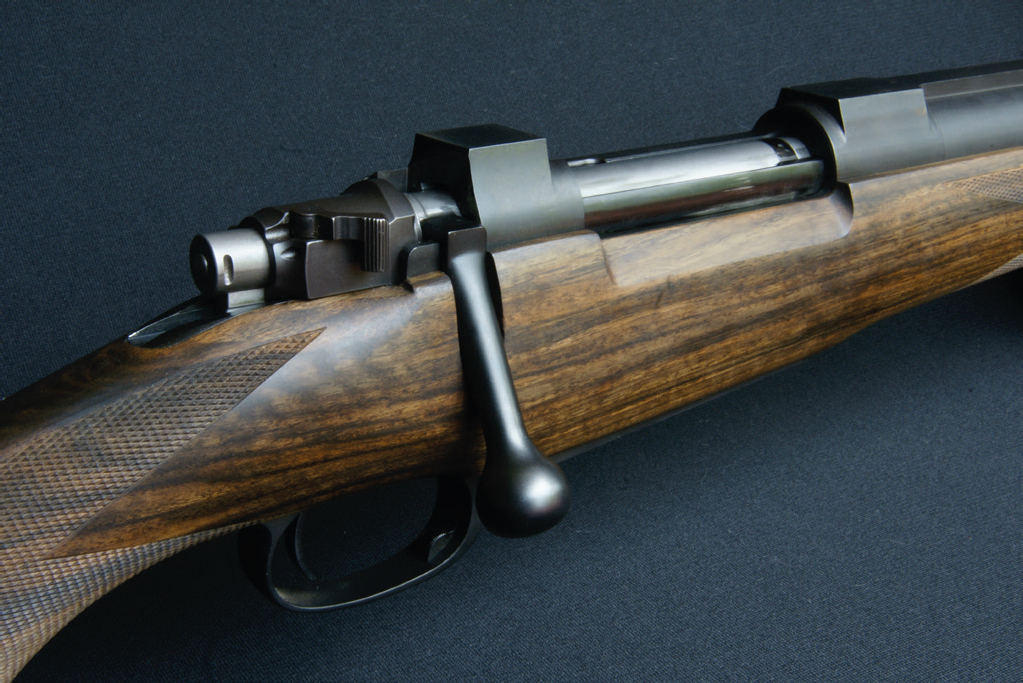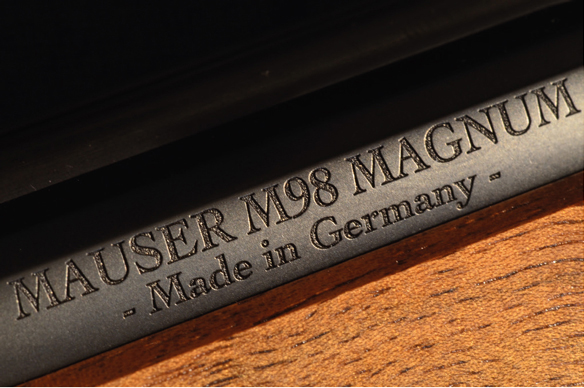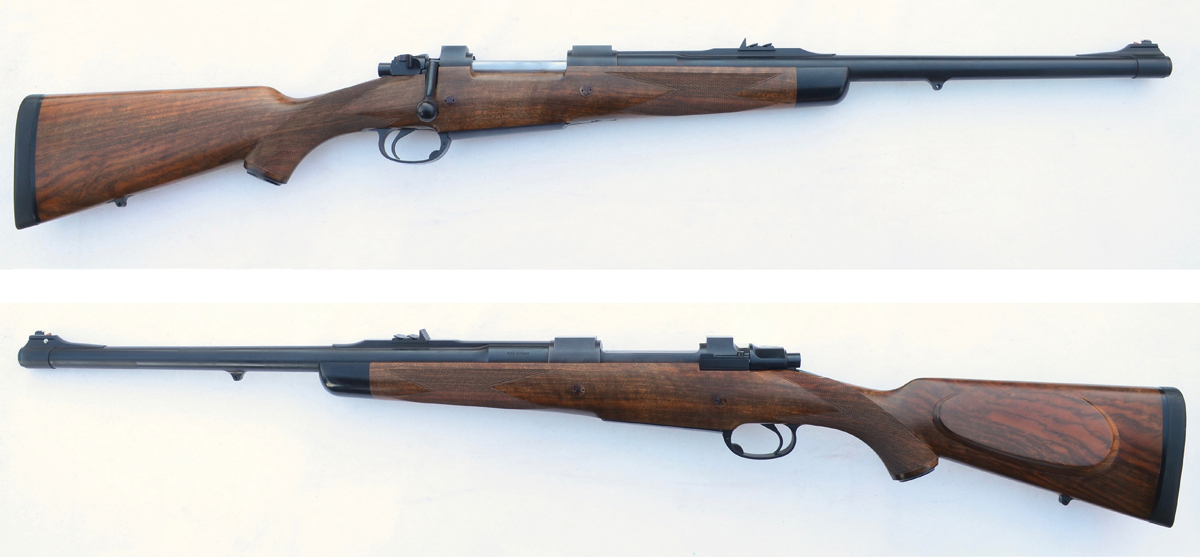
THE MAGNUM MAUSER
In 1898, John Rigby & Co. of London became Mauser’s English agent and the sole distributor of Mauser 98 rifles, actions, and barreled actions throughout the British Empire. Almost immediately, Rigby asked the Mauser-Werke to produce a slightly longer action, to accommodate the .400/.350 Rigby, one of the company’s double-rifle cartridges. Mauser complied, and around 1900 delivered an action that was .400 inches longer than standard. To accommodate the rimmed .400/.350, it had a slanted magazine box.
From this modest beginning grew the Magnum Mauser action of lore and legend. Before long, Rigby was importing these for sale to other gunmakers, who chambered suitable big cartridges for them, such as W. J. Jeffery’s .404 in 1909. Mauser itself also made finished rifles using the action, among them the .404 and the .280 Ross. In 1910, Rigby introduced its most famous cartridge, the .416 Rigby, and ever since it has been the cartridge most associated with the magnum action. The other major development in this regard was the introduction, in 1911, of the huge .505 Gibbs.
No one knows for certain exactly how many magnum actions were produced, but relatively speaking, it was not many. It is estimated that over the forty-seven-year period between the introduction of the Mauser 98, and the shutdown of commercial manufacture at Mauser in 1946, a grand total of about 125,000 sporting rifles were made. That includes both finished rifles and actions of all sizes.
From the beginning, Oberndorf magnum actions were expensive and hard to get. Combined with the romance and allure of such cartridges as the .416 Rigby and .505 Gibbs, they became a benchmark for desirability, and this translated into high prices. Magnum Mauser actions were never cheap, selling for $500 in the white when you could buy a very decent American-made rifle, complete, for $100.
As wars started and ended, economic woes came and went, and production at the Mauser-Werke ebbed and flowed, obtaining a magnum action at any price presented difficulties. It was not surprising, then, that the magnum Mauser was the action that other civilian manufacturers (as opposed to military suppliers, like FN) tried to duplicate. In the 1960s, the most notable of these was the French Brevex, which was both hard to get and difficult to work with. In the United States, Fred Wells, the Prescott, Arizona gunsmith who was America’s reigning Mauser expert, produced some magnum actions virtually by hand. Wells, in turn, inspired Mike Roden, another Prescott-dwelling Mauser admirer, to found Granite Mountain Arms with the avowed intention of producing absolute, true-to-original-form Mauser 98 actions in all the original sporting configurations—standard, kurz, square-bridge, round-top, and magnum. Through the 1990s, Granite Mountain actions became the standard against which all other Mausers were measured. They were (and are) superbly made and priced accordingly.
This magnum Mauser action was made by Fred Wells of Prescott, Arizona.
In Germany, a few companies also produced Mauser actions, including Prechtl, which supplies actions to high-end custom shops like Hartmann & Weiss. Prechtl also supplied the actions for the prototype “Original Mauser” 98s from the Mauser company around 2010.


Magnum Mauser, in .375 H&H, made by Mauser in Germany.
The most famous British cartridge of all, the .375 H&H, introduced in 1912, does not require a magnum action. With a bit of cutting and filing, it fits nicely in the standard-length Mauser. When FN began producing its so-called magnum line for Browning in the 1960s, its “magnum” actions were standard actions that had been opened up. However, when Mauser (the modern company) seriously returned to the 98 in 2015, the first rifles were built on square-bridge magnum actions, and the two initial chamberings were .416 Rigby and .375 H&H. An interesting sidelight is that the most recent 98s were created by Mauser at the behest of John Rigby & Co., now returned to London after fifteen years in an American wilderness of fraud and theft. The new John Rigby & Co. is owned by the same company that owns Mauser. They have come full circle, a mirror image of the saga of Winchester, Browning, and FN.
* * *
The rifle shown at the beginning of this chapter is a Granite Mountain .505 Gibbs, built in 2009, custom-stocked and checkered. It has a 22-inch barrel and no provision for a scope. Instead, it has iron sights on an integral quarter-rib and a barrel-band front sight, with a standard bead and folding moon sight. Unloaded with no sling, it weighs 10 1/2 pounds. Throw in a sling and three of the massive .505 cartridges, and it tops eleven pounds easily.
There is only 1.5 pounds difference between this rifle and my .450 Ackley, but the difference in handling qualities is remarkable. The pistol grip and forend of the .505 are both considerably larger in circumference, and consequently more difficult to grip. In turn, it makes the rifle hard to handle.
There is little that can be done about this with such a large cartridge. Obviously, you need the magnum Mauser action, and the barrel will be thicker, heavier, and require a forend that is commensurately larger. In turn, so as not to look out of proportion, the pistol grip will also be thicker. And, inevitably, there is always the question of strength to withstand the .505’s punishing recoil.
When I had this rifle made, I wanted one standing leaf for the rear sight, and no folding ones. My plan was to sight-in the rifle so that the bullet crossed the line of sight for the first time at 20 yards. It would then be sighted in for whatever distance the bullet crossed the line of sight coming back down—80 to 100 yards, most likely. A .505 is an elephant gun first and foremost, and elephants are not hunted at long range. Therefore, a rifle sighted dead on at twenty yards would be the most useful, but you would still have usable trajectory out to one hundred yards or so. Beyond that range is beyond the .505’s practical limit. Because of this plan, I wanted no folding leaves on the rear sight. Leaves that are folded down can pop up under recoil, especially this kind of recoil, and get in the way. I wanted no chance of that. The folding moon sight presented the same potential problem, but I raised no objections, thinking I would probably use the moon most of the time anyway.
I spent an afternoon with the rifle, firing one shot after another at a 20-yard target while a gunsmith filed a notch into the standing rear blade. When it was planting its bullets one on top of the other in the bull, he stopped filing and I stopped shooting. My shoulder was grateful, since I had done exactly the same thing, earlier in the day, with another .505 Gibbs built on one of Fred Wells’s magnum Mauser actions. As a day of shooting goes, it was certainly an experience. It is quite remarkable how you can bear down and not jerk the trigger when you know that, if you get a flyer, you will just have to repeat the shot anyway.

Custom .505 Gibbs, built on their magnum action by Granite Mountain Arms. Hemingway’s fictional professional, Robert Wilson, called his .505 Gibbs “this damned cannon.” One can see why.
The ammunition we used was Norma’s “African PH” loaded with the 600-grain Woodleigh Protected Point soft-nosed bullet. It had always seemed to me that George Gibbs missed a trick in designing his mammoth cartridge to shoot a 525-grain bullet—which is light by .500-caliber standards—when a 600-grain would equal and even out-do the .500 Nitro Express with its 570-grain. To my knowledge, no one ever complained about the 525’s stopping power, so I may have been over-analyzing and over-correcting. I’ve been known to do that. Still, 600 grains seemed a better weight. It’s a terrific bullet, and both bullets and loaded ammunition are readily available.
* * *
Dangerous-game rifles constitute a whole separate area of discussion when it comes to hunting rifles. The disparate requirements and effects of recoil, weight, and power largely preclude the kind of handling that is possible with a Mannlicher-Schönauer 1903 or a Winchester 92. Practically speaking, rifles for dangerous game can be divided into two groups, one starting with the .375 H&H and ranging up to the .470 NE, and the other beginning with the .500 NE and continuing up to the .600 NE. We won’t even include such monsters as the .700 H&H, or the old 4- and 8-bores. Those require rifles so heavy they are not really practical for any kind of hunting.
As I have mentioned, it is possible to build a .500 NE in a double rifle that is light enough to carry and still pleasant to shoot. The same is true of bolt-rifle cartridges like the .458 Lott and .450 Ackley. Beyond that, when you get into the .500 Jeffery and .505 Gibbs, the rifles become both heavy and cumbersome. In the days of professional ivory hunting in Africa, hunters might have had a .577 or .600 NE for the worst contingencies, but they were carried by gunbearers while the hunter himself carried something lighter, like a .450.
Unless you are possessed of bodybuilder strength, it is not possible to carry a sixteen- or eighteen-pound rifle through rough country, hour after hour, and still have the strength to handle it quickly when you need to.
In bolt rifles, the two big cartridges that get the most attention are the .500 Jeffery and the .505 Gibbs. Factory rifles are available for both, and Norma offers both calibers in its African PH line of ammunition. There have been attempts to make even more powerful magazine-rifle cartridges. Usually these are .577 caliber, based on something like the .50 Browning machine gun case. Most of these seem to me to be merely stunts, gunmakers trying to momentarily claim the crown for “most powerful,” as if that’s worth anything. Wildcatters who have created some of these quickly find they will run into all kinds of ballistic obstacles, such as getting a powder slow enough to work, and which, in that great a volume, can actually be ignited by a conventional primer.
About a decade ago, I was granted the privilege of trying out a .585 GMA, which is an oversized number developed by Granite Mountain for chambering in their magnum action. It used a .577 bullet, and the case was as long as a banana. There had been repeated ignition problems with it during development. I took solid hold, braced myself, pulled the trigger, and “click.” I lowered the rifle and was turning my head to say something when the rifle finally went off. It was the longest hangfire I’ve ever experienced. The rifle leapt skyward with me hanging on as it came over my head in an arc and ended up pointing at the rapidly parting crowd behind me. Fortunately, I didn’t lose my grip so the $15,000 rifle did not end up in the gravel.
As these kinds of problems mount up, the reliability of the rifle suffers. In a rifle for dangerous game, reliability is everything. No matter how much power you have, no matter how accurate it is, no matter how heavy the bullet, if the rifle does not feed, fire, eject, feed, and fire again, shot after shot without a shadow of doubt, then you should trade it off and get something that does.
The British had by far the most experience with dangerous game all over the world. They developed rifles and cartridges for the purpose, and found that there was a practical upper limit beyond which the problems mounted up so fast that rifles quickly became useless. We talk about the .600 NE with bated breath, but it was both a late-comer and something of a curiosity. Introduced by W. J. Jeffery around 1900, only around one hundred rifles were made in total, including both doubles and single-shots. It was just too big and too heavy.
The .577 Nitro Express, on the other hand, was made in considerable numbers and used by many elephant hunters. Rifles are heavy but not totally unmanageable, recoil is tolerable in small doses, and anything a .577 NE can’t do, probably can’t be done. It was no one’s everyday rifle, except perhaps Jimmy Sutherland, who had a pair of them. Old-time professional hunter Tony Henley told me that he once had the use of one of Sutherland’s .577s for a season, and found it gave incredible penetration and stopping power. For his last years of hunting, however, Tony carried a H&H .500/.465 and considered it more than adequate for Cape buffalo and elephant.
Since interest in the big .500s for bolt rifles was rekindled, they have become available in various rifles. CZ offers both in its magnum bolt action, and Blaser even chambers its R8 straight-pull rifle for the .500 Jeffery. Former Zimbabwe PH Don Heath, when he was with Norma, told me a few years ago that .500 Jeffery ammunition outsold .505 Gibbs by a ratio of six to one. There is certainly more interest in the .500 Jeffery, probably because on paper it is the more powerful of the two and, being smaller, does not need as large an action.
No matter how I try, however, I cannot understand why anyone would buy a CZ magnum rifle in .500 Jeffery in preference to the Gibbs. You have to carry the extra weight anyway, so why not get the unassailable advantages of the .505? Personally, I prefer the Gibbs for its roomy case, lower pressures, and long neck, which grips heavy bullets under recoil better than the stubby neck of the .500. It does not have a rebated rim, with any of the real and theoretical problems that presents, so it should have both more reliable feeding and surer extraction with the Mauser extractor. And if the Gibbs requires a bigger, heavier action, and hence a heavier rifle, that is all to the good. For those so inclined, by the way, the Gibbs can be handloaded to out-perform the Jeffery, though I don’t believe that is a rational activity for any sane person.
The Granite Mountain .505 Gibbs shown here represents the upper limit of hunting rifles, by our definition, in weight, size, and power. If I were going elephant hunting, I would retain a gunbearer to carry the .505 while I carried my .450 Ackley. Those professional elephant hunters of old knew what they were doing.
* * *
Schultz & Larsen Model 65DL, .358 Norma.